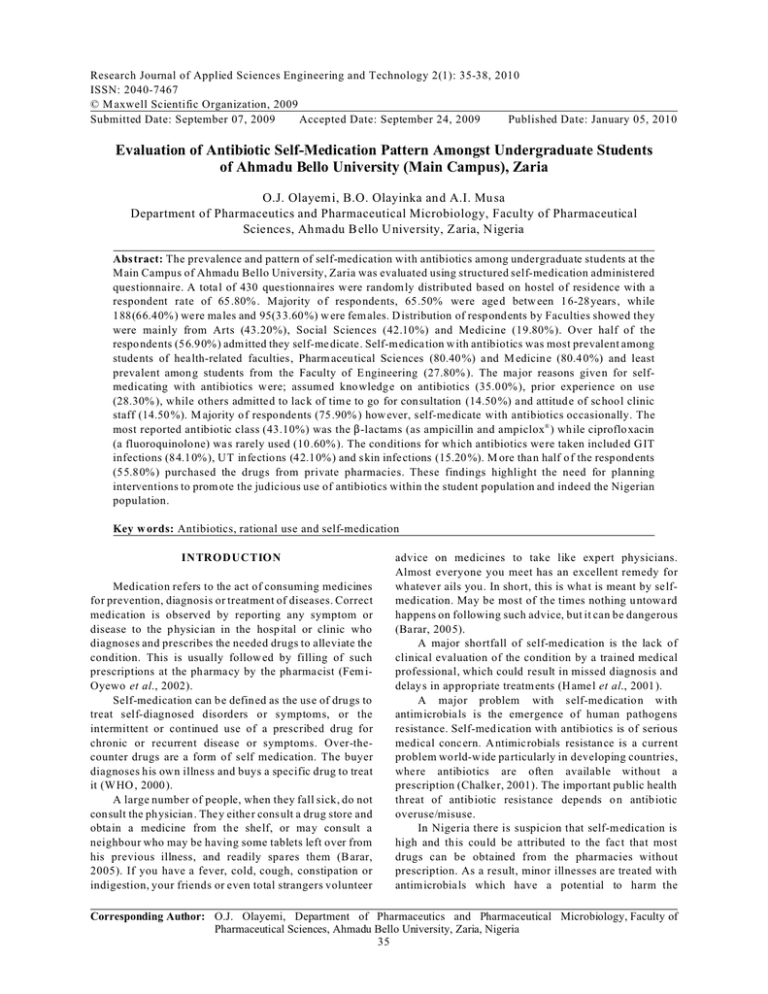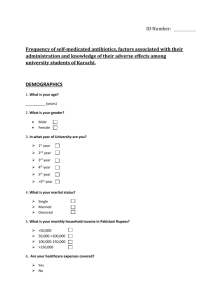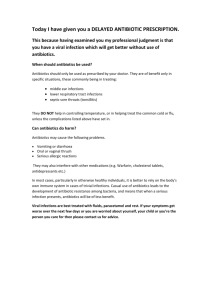Research Journal of Applied Sciences Engineering and Technology 2(1): 35-38,... ISSN: 2040-7467 © M axwell Scientific Organization, 2009
advertisement

Research Journal of Applied Sciences Engineering and Technology 2(1): 35-38, 2010 ISSN: 2040-7467 © M axwell Scientific Organization, 2009 Submitted Date: September 07, 2009 Accepted Date: September 24, 2009 Published Date: January 05, 2010 Evaluation of Antibiotic Self-Medication Pattern Amongst Undergraduate Students of Ahmadu Bello University (Main Campus), Zaria O.J. Olayem i, B.O. Olayinka and A.I. Mu sa Department of Pharmaceutics and Pharmaceutical Microbiology, Faculty of Pharmaceutical Sciences, Ahmadu B ello U niversity, Zaria, Nigeria Abstract: The prevalence and pattern of self-medication with antibiotics among undergraduate students at the Main Campus of Ahmadu Bello University, Zaria was evaluated using structured self-medication administered questionnaire. A total of 430 questionnaires were random ly distributed based on hostel of residence with a respondent rate of 65.80% . Majority of respondents, 65.50% were aged betw een 1 6-28years, while 188(66.40%) were males and 95(33.60%) w ere fem ales. D istribution of respondents by Faculties showed they were mainly from Arts (43.20%), Social Sciences (42.10%) and Medicine (19.80%). Over half of the respo ndents (56.90%) adm itted they self-me dicate. Self-medication w ith antibiotics was most prevalent among students of health-related faculties, Pharm aceu tical Sciences (80.40 %) and M edicine (80.4 0%) and least prevalent amon g students from the Faculty of E ngineering (27.80% ). The major reasons give n for selfmedicating with antibiotics w ere; assumed knowledg e on antibiotics (35.00% ), prior experience on use (28.30% ), while others admitted to lack of time to go for con sultation (14.50 %) and attitud e of school clinic staff (14.50 %). M ajority of respondents (75.90% ) how ever, self-medicate with antibiotics occasionally. The most reported antibiotic class (43.10%) was the $-lactams (as ampicillin and ampiclox® ) while ciproflo xacin (a fluoroquinolone) wa s rarely used (10 .60% ). The conditions for which antibiotics were taken included GIT infections (84.10%), UT infections (42.10%) and skin infections (15.20 %). M ore than half of the resp ondents (55.80%) purchased the drugs from private pharmacies. These findings highlight the need for planning interventions to prom ote the judicious use of antibiotics within the student population and indeed the Nigerian population. Key w ords: Antibiotics, rational use and self-medication INTRODUCTION Medication refers to the act of consuming medicines for prevention, diagnosis or treatment of diseases. Correct medication is observed by reporting any symptom or disease to the physician in the hosp ital or clinic who diagnoses and prescribes the needed drugs to alleviate the condition. This is usually follow ed by filling of such prescriptions at the ph arma cy by the pharma cist (Fem iOyewo et al., 2002). Self-medication can be defined as the use of dru gs to treat self-diagnosed disorders or symptoms, or the intermittent or continued use of a prescribed drug for chronic or recurrent disease or symptoms. Over-thecounter drugs are a form of self medication. The buyer diagnoses his own illness and buys a specific drug to treat it (WHO , 2000 ). A large number of people, when they fall sick, do not consult the physician . They either consult a drug store and obtain a medicine from the shelf, or may con sult a neighbour who may be having some tablets left over from his previous illness, and readily spares them (B arar, 2005). If you have a fever, cold, cough, constipation or indigestion, your friends or even total strangers volunteer advice on medicines to take like expert physicians. Almost everyone you meet has an excellent remedy for whatever ails you. In short, this is what is meant by selfmedication. May be most of the times nothing u ntowa rd happens on following such advice, but it can be dangerous (Barar, 200 5). A major shortfall of self-medication is the lack of clinical evaluation of the condition by a trained medical professional, which could result in missed diagnosis and delay s in appropriate treatm ents (H ame l et al., 2001 ). A major problem with self-medication with antimicrobials is the emergence of human pathogens resistance. Self-med ication with antibiotics is of serious medical conc ern. A ntimicrobials resistance is a current problem world-wide particularly in developing countries, whe re antibiotics are often available without a prescription (Chalker, 2001). The impo rtant public health threat of antibiotic resistance depe nds o n antibiotic overuse/misuse. In Nigeria there is suspicion that self-medication is high and this could be attributed to the fac t that most drugs can be obtained from the pharmacies without prescription. As a result, minor illnesses are treated with antimicrobials which have a potential to harm the Corresponding Author: O.J. Olayemi, Department of Pharmaceutics and Pharmaceutical Microbiology, Faculty of Pharmaceutical Sciences, Ahmadu Bello University, Zaria, Nigeria 35 Res. J. Appl. Sci. Eng. Technol., 2(1): 35-38, 2010 Tab le 1: D istribu tion o f age and gen der o f stud ents w ho s elf-m edic ate Age g roup (years) M ale Fem ale ----------------------------------------------No .% No. % 16-25 104 36.75 87 30.74 26-35 79 27.92 8 2.83 36-45 5 1.77 individual as we ll as the society at large (Akinyede and Banjo, 2001). This work evaluated the involvement, prevalence and factors responsible for antibiotic selfmedication amo ngst stu dents of a tertiary institution in Northern Nigeria (A hmad u Bello U niversity, Zaria). MATERIALS AND METHODS Table 2: Course of study and frequency of self-medication Fac ulty No. of Frequency resp ond ents of SM Pharmaceutical Sciences 51 41 Medicine 56 45 Sciences 58 30 Arts 44 19 Social Sciences 38 16 Engineering 36 10 Total 283 161 A comm unity based cross-sectional surv ey was conducted on the main campu s of A hma du B ello University, Zaria. H ealth services on the camp us are provided b y the S ickba y of the unive rsity. Self administered, structured questionnaires were designed for the purpose of data collection. The questionnaires consisted of both closed- and sometimes open-ended questions. The inform ation o n the questionnaires included social demographic variables such as age, gen der, marital status, nationality and course of study. In addition to qu estions on demo graphic information, the questionnaire included questions on involvement in self medication practices, frequency of self medication, sources of antibiotics used, reasons for self-prescribing of antibiotics, names of antibiotics used amongst other information. The questionnaires were rando mly distributed to the students based on hostel residence which were later sorted according to faculties. Generally, simple percentages were used in the analysis and interpretation of the results. Table 3: Frequency of self-medication Respo nse Frequency Oc casio nally 198 Freq uen tly 44 “Mo st of the time” 19 % 80.39 80.36 51.72 43.18 42.11 27.78 56.89 % 75.86 16.86 7.28 Table 4: Conditions for which students self-medicated Condition N o. (% ) G.I.T Infections 238 (84.10) Genitourinary Infections 119 (42.05) Respiratory Tract Infections 49 (17.30) Skin Infections 43 (15.19) RESULTS The distribution of age, gender and course of study are show n in Table 1 and 2. Four hundred and thirty (430) questionnaires were distributed and two hundred and eighty three (283) students responded. The distribution showed that 191 (66.49%) students were between the ages of 16 and 25 years with 188 (66.43%) being males and 95 (33.57%) females. Fifty one (1 8.02%) w ere in the faculty of Pharmaceutical sciences while 56 (19.79%) w ere in Medicine, 38 (42.11%) were in social sciences, 44 (43.18%) were in Arts and 36 (12.72%) in Engineering. A little more than half of the respondents 161 (56.89%) admitted to self medication w ith antibiotics. The students from the faculty of Pharmaceutical sciences 41 (80.39%) recorded the highest in self medication practices and these were closely followed by students from the faculty of Medicine 45 (80.36%) while the least record was from students of the faculty of Engine ering (27.78% ). The major reasons given for this practice included assumed knowledge on antibiotics (34.98%), prior experience on use (28.27%), lack of time to go for consultation (14.49%) and the attitude of the school sickbay staff (14.49%). Only 11.31% reported that the nature of the illnesses were not serious enough for consultation as observed in Table 3. Most of the respo ndents (75.86%) reported they get in invo lved in self medication “occasionally”, 16.86% claim to self me dicate Table 5: Factors influencing self-medication Reasons for SM Frequency Knowledge about drugs 99 Prior experience on u se 80 Lack of time 41 Fina ncia l con straints 37 Non chalant attitude of clinic staff 41 Illness considered not serious for consultation 32 Othe rs 20 % 34.98 28.27 14.49 13.07 14.49 11.31 7.07 Table 6: Type of antibiotics used in self-medication Antibiotics Frequency Am oxic illin 38 Tetracycline 61 Cip roflo xac in 30 Co -trimo xaz ole 57 Am picillin 122 M etron idaz ole 72 % 13.43 21.55 10.60 20.14 43.11 25.44\ Table 7: Source of purchase of antibiotics Place Frequency Hospital 37 Comm unity pharmacy 158 Priv ate clin ic 5 Patent m edicine s tore 91 % 13.07 55.83 1.77 32.16 “frequently” while the remaining respondents admitted they self medicate “most of the tim e” as seen in Table 3. Majority of the students 238 (84.10%) reported that they self med icated for gastrointestinal infections (G IT), 119 (42.08% ) for genitourinary infections, 49 (17.30%) and 43 (15.15%) for respiratory tract infections (RTI) and skin infections respectively (Table 4). The most common antibiotic that was reported for self medication is Am picillin 122 (43.11) as indicated in Table 6 followed 36 Res. J. Appl. Sci. Eng. Technol., 2(1): 35-38, 2010 by M etronidazole 72 (25.44%) then Tetracycline 61 (21.55% ), Co-trimoxazole 57 (20.14%) and Ciprofloxacin 30 (10.60%). One hundred and fifty eight (55.83%) of the respo ndents purchased the drugs directly from private pharmacies (Table 7). Other sources of the drugs included patent medicine stores 91 (32.16%), left-over drugs from previous prescriptions 42 (14.84% ). medicated. The use of these drugs for self-medication correlates with the study by Akinyede and Banjo, 2001. A major problem of self-medication with antibiotics is the emergence of drug resistance. Antimicrobial resistance is a curren t problem w orld-w ide; particularly in developing countries. It is widely believed that malpractices such as inad equate dosing, inc omp lete treatment courses and indiscriminate drug use have contributed to the emergence and spread of antimicrobial resistance (Abde l-Hameed, 2001). The consequence of this is the loss of relatively cheap drugs that will require new drugs development, which will be more expensive and will further put develo ping c ountries at a disadvantage. The rational use of antibiotics is thus of utmost importance to limit the increase in bacterial resistance. From the study, the major source of purchase of antibiotics was community pharmacies (Table 7). Though regulations that categorise most of these drugs as prescription only exist, regulatory authorities often lack resources to enforce them. Even if enforcement was possible, having and enforcing a strict prescription policy without providing adequate and affo rdable access to medical consultation and treatment, might exclude the poorest from accessing drugs, leading to increased morbidity from oth erwise treatable infectious diseases. There are concerns that most of these antibiotics were obtained from the community pharmacist without prescription from q ualified personnel, therefore, those involved in sale network should focus on practicing within the expected framew ork of their profession. They are encouraged to sell over-the-counter drugs alone for self-medication purposes. (Akinye de and B anjo, 2001 ). Imple mentation of pha rmaceutical care in comm unity pharmacies could help alleviate this prob lem. C omm unity pharmacists can be involved in educating their clients as to the drugs for self-medication and the dange r of selfmedicating with antibiotics and other prescription on ly drugs. DISCUSSION The occurrence of antibiotic self-medication among Ahmadu Bello University undergraduate stud ents is considerably high. S imilar find ings have b een reported in some other Nigerian universities (Akinyede and Banjo, 2001; Femi-Oyewo et al., 2001). The m ajor factors associated with self medication with antibio tics is assumed knowledge on diseases and their treatments, financial status, prior experience on use of antibiotics, lack of time and “unseriousness” of the nature of illness. From this study, self medication with antibiotics was found to be domin antly related to assumed knowledge on antibiotics (Table 5) as the major “culprits” of th is practice were the stu dents in the faculties of pharmacy and medicine who have better knowledge on diseases and therapeutics. Although these students admitted to having knowledge on antibiotics, consequences of their misuse and hazards associated with self medication but alarmingly, these did not deter them from indulgin g in this practice. Students in the faculties of pharmacy and medicine claimed they got involved in this practice because of their tight academic schedules and as such they could not follow lengthy procedures before consultation with a docto r. On the other hand, students of non-health related faculties got involved in this practice based on the assumption that same or sim ilar symptom s of a disease or infection could be treated with same drug and regimen as used earlier. These drugs may have been prescribed initially but they keep purchasing the same drugs or just use up the “left-overs” when ever the symptoms reappear. Other students claimed that the negative attitude of some sickbay staff kept them away from the clinic and so, indulge in self-medication with antibiotics when they need ed m edication. The disease conditions for w hich the students selfmedicated differ from those reported in a similar study carried out by Akinyede an d Banjo in the College of Med icine, University of Lagos. T hese conditions are common health problems among many populations and this suggests that the trend of antibiotic self-medication may continue if proper measures are not taken. Am picillin was reported as the main dru g used to self-med icate in this study (Table 6) and this correlates with the “assumed knowledge” of dru gs as a mpic illin is probably used here because of its broa d spectrum in addition to metro nidaz ole and tetracycline to treat GIT infections which is the major disease for which these students self CONCLUSION The results from this study are limited to self reported data, and as with all self reported data, it depends on information given by the respondents. This study shows that self-medication with antibiotics is common, inapp ropriate and this is in line with similar studies carried out in some Nigerian Universities. With these results, it is believed that health policy makers will take appropriate steps to preve nt antibiotic misuse and further strengthen the legislation governing the sale of prescription drugs without prescription (over-the-counter). REFERENCES Abdel-Hameed, A.A., 2001. Malaria case management at the comm unity level in Gezira, Sudan. Afr. J. Med. Sci., 30: 43-46. 37 Res. J. Appl. Sci. Eng. Technol., 2(1): 35-38, 2010 Akinyede, A.A. and S.O. Banjo, 2001. A review of the self-medication practices by students of tw o hea lth training institutions in Lagos. N ig. J. Pharm., 32: 51-55. Barar, F.S.K., 2005. Dangers of Self-Medication. www.boloji.com. Chalker, J., 2001. Imp roving antibiotic prescribing in Hai Phong Province, Viet Nam: he “antibiotic-dose” indicator. Bulletin of the World Health Organization, 79(4). Femi-Oyewo, M.N ., O.E. Adejumo and S.A . Hassan, 2002. Self-medication Pattern among Students of Olabisi Onaban jo University, Ogun State. Nig. J. Pharm., 1(1): 17-20. Hamel, M.J., A. Odhacha and J.M. Roberts, 2001. Malaria contro l in Bungoma D istrict, Kenya: A survey of home treatment of children w ith fever, bednet use and attendance at antenatal clinics. Bulletin of the W orld Health Organization, 79: 1014-1023. WHO, 2001. Guidelines for the regulatory assessment of med icinal products for use in self-medication. W HO/ED M/QSM /00.1. 38




